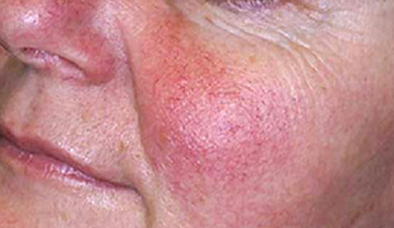Rosacea is a specific chronic skin condition that is classified as an inflammatory dermatosis, and it is typically observed on persons’ faces. In order to focus on the most effective treatment therapies, it is important to discuss characteristic features of this disorder and its etiology. The signs of rosacea include inflammations on a forehead, a nose, cheeks, and a chin (Li, Cho, Khalili, Wu, & Chan, 2016). Furthermore, the symptoms of this disorder also include erythema, edema, inflammatory papules, and plaques (Figure 1).

Depending on the observed symptoms and locations of inflammations, rosacea is classified into several specific subtypes: papulopustular, erythemato-telangiectatic, ocular, and phymatous rosacea (Picardo, Eichenfield, & Tan, 2017). While speaking about the etiology of these types of rosacea, it is important to note that there are debates regarding actual causes of this disease. Researchers note that genetic profiles of persons play an important role in provoking the development of rosacea (Li et al., 2016). It was found that some genes can cause the development of this condition under certain circumstances, and other important factors include gender and age of individuals (Picardo et al., 2017).
In addition, there are studies that support the association between the development of different types of rosacea and the progress of certain diseases. According to researchers, such chronic diseases as hyperlipidemia, metabolic diseases, gastroesophageal reflux disease, diabetes, and cardiovascular diseases can cause the development of rosacea symptoms (Li et al., 2016; Picardo et al., 2017). Nevertheless, additional research is still required in this field in order to provide more evidence regarding actual risks which are related to the progress of rosacea. In spite of the fact that much attention is paid to genetic factors, environmental factors should also be taken into account while discussing the etiology of rosacea. Researchers have provided evidence that this disorder is more typical of light-skinned individuals who live in countries of North Europe and North America (Chang, Kurian, & Barankin, 2014). Cases of rosacea among persons whose skin is dark are rare.
The traditional treatment of rosacea includes the use of metronidazole as an anti-inflammatory medication, the use of azelaic acid as an anti-inflammatory and antibacterial medication, and the use of tetracyclines. Antibiotics have been proved to be effective to overcome signs of rosacea, especially, with the focus on treating ocular rosacea (Chang et al., 2014). Currently, more attention is paid to using new approaches to treating this disorder. The focus is on prescribing topical ivermectin and topical brimonidine among other types of therapies. In addition to using medications, laser and light techniques to cope with symptoms of rosacea are also recommended for the majority of patients (Chang et al., 2014; Li et al., 2016). These therapies are discussed as effective to overcome signs which are associated with erythemato-telangiectatic rosacea.
After focusing on symptoms and etiology of rosacea, as well as available treatment options, it is possible to conclude that this disorder requires further investigation in order to understand what specific causes are associated with its development. Much attention should be paid to examining factors which can lead to the appearance of symptoms of rosacea in persons who have a light color of skin. Thus, it is necessary to become aware of particular genetic and environmental factors which can cause the progress of this disease.
References
Chang, B. P., Kurian, A., & Barankin, B. (2014). Rosacea: An update on medical therapies. Skin Therapy Letter, 19(3), 1-4. Web.
Li, W. Q., Cho, E., Khalili, H., Wu, S., & Chan, A. T. (2016). Rosacea, use of tetracycline, and risk of incident inflammatory bowel disease in women. Clinical Gastroenterology and Hepatology, 14(2), 220-225. Web.
Picardo, M., Eichenfield, L. F., & Tan, J. (2017). Acne and rosacea. Dermatology and Therapy, 7(1), 43-52. Web.